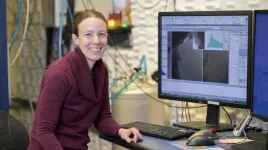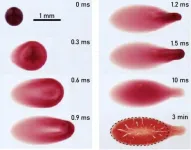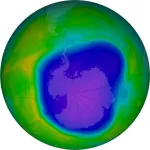(Press-News.org)
Leipzig/Mainz. The extent to which aerosol particles affect the climate depends on how much water the particles can hold in the atmosphere. The capacity to hold water is referred to as hygroscopicity (K) and, in turn, depends on further factors – particularly the size and chemical composition of the particles, which can be extremely variable and complex. Through extensive investigations, an international research team under the leadership of the Max Planck Institute for Chemistry (MPIC) and the Leibniz Institute for Tropospheric Research (TROPOS) was able to reduce the relationship between the chemical composition and the hygroscopicity of aerosol particles to a simple linear formula. In a study that appeared in the journal Nature Communications, they showed that hygroscopicity, averaged globally, is essentially determined by the share of organic and inorganic materials making up the aerosol.
The hygroscopicity of aerosol particles is an important factor in the effect of aerosol particles on the climate and thus also for forecasting changes to the climate using global climate models. "The capacity to hold water depends on the composition of aerosol particles, which can vary considerably in the atmosphere. However, in our study we were able to show that simplified assumptions can be made for the consideration of hygroscopicity in climate models," explains Mira Pöhlker. She is in charge of the "Atmospheric Microphysics" department at TROPOS and is a professor at the University of Leipzig. According to the aerosol and cloud researcher, this is the first study to use measurement results from across the world to show that a simple linear formula can be used without creating huge uncertainty in climate models.
For this purpose, Mira Pöhlker's team evaluated data from 16 measurement campaigns between 2004 and 2020, in which hygroscopicity was determined by means of cloud condensation nuclei measurements and the chemical composition of particles by means of aerosol mass spectrometry. The extensive data covered a wide range of Earth's regions and climate zones: From the Amazon's tropical rainforest through metropolitan regions with significant air pollution in Asia to the boreal pine forest of the Arctic Circle in Europe.
The evaluation of these data sets revealed: Effective aerosol hygroscopicity (κ) can be derived from the share of organic materials (ϵorg) and inorganic ions (ϵinorg) using a simple linear formula (κ = ϵorg ⋅ κorg + ϵinorg ⋅ κinorg). "Despite the chemical complexity of the organic matter, its hygroscopicity is successfully captured by the simple formula," explains Christopher Pöhlker, Group Leader at the Max Planck Institute for Chemistry and co-author of the study. When averaged globally, he reports, hygroscopicity is κorg= 0.12 ± 0.02 for organic particle shares and κinorg = 0.63 ± 0.01 for inorganic ions.
Effect of the new formula on climate forecasts
To test the new formula, the researchers used the global aerosol climate model ECHAM-HAM. "In our study, we were able to use experiments to show that simplified assumptions can be made in this area without causing great uncertainty in the model results. This means that investigations and forecasts relating to climate change are more reliable," Mira Pöhlker says in summary. "Our study was enabled by measurement campaigns with international partners at a wide variety of locations worldwide as well as by long-term observations at particular research stations, such as the ATTO observatory in the Brazilian rainforest," reports Christopher Pöhlker from the Max Planck Institute for Chemistry in Mainz.
Scientific background:
The interactions of atmospheric aerosols with solar radiation and clouds continue to be inadequately understood and are among the greatest uncertainties in the model description and forecasting of changes to the climate. One reason for this is the many unanswered questions around the hygroscopicity of aerosol particles. Depending on size and chemical composition, tiny aerosol particles can hold different amounts of water. This is important both for the scattering of solar radiation by the aerosol particles themselves as well as for the formation of cloud droplets. Particles that hold more water scatter more sunlight back into the universe and can also have a cooling effect through the formation of more cloud droplets.
END
Effect of aerosol particles on clouds and the climate captured better
Global measurements and model calculations show that the complex relationship between the chemistry and climate impact of aerosol particles can be successfully captured by a simple formula.
2023-11-21
ELSE PRESS RELEASES FROM THIS DATE:
Hydrogen detected in lunar samples, points to resource availability for space exploration
2023-11-21
WASHINGTON – U.S. Naval Research Laboratory (NRL) researchers have discovered solar-wind hydrogen in lunar samples, which indicates that water on the surface of the Moon may provide a vital resource for future lunar bases and longer-range space exploration. Space-based resource identification is a key factor in planning for civilian- and government-led space exploration.
“Hydrogen has the potential to be a resource that can be used directly on the lunar surface when there are more regular or permanent ...
How gut microbes help alleviate constipation
2023-11-21
Scientists have identified the genes in the probiotic Bifidobacteria longum responsible for improving gut motility. A research team reporting November 21st in the journal Cell Host & Microbe found that B. longum strains possessing the abfA cluster of genes can ameliorate constipation through enhanced utilization of an indigestible fiber called arabinan in the gut.
“We established the causal link between a genetic variant—the abfA cluster—to the key functional difference of probiotic B. longum in multiple model organisms, including mice and humans, and provided mechanistic and ecological insights ...
Written in blood
2023-11-21
WASHINGTON, Nov. 21, 2023 – Forensic science has captured the public imagination by storm, as the profusion of “true crime” media in the last decade or so suggests. By now, most of us know that evidence left at a crime scene, such as blood, can often reveal information that is key to investigating and understanding the circumstances around a crime — and that scientific methods can help interpret that information.
In Physics of Fluids, by AIP Publishing, a group of scientists from Boston University and the University of Utah demonstrated ...
Unstable housing and mortality among veterans receiving dialysis
2023-11-21
About The Study: In this study of 25,000 veterans receiving dialysis, unstable housing experienced before starting dialysis was associated with increased risk of all-cause mortality, and risks increased with age. Further efforts are needed to understand the experiences of older adults with unstable housing and to estimate the scope of unstable housing among all individuals receiving dialysis.
Authors: Tessa K. Novick, M.D., M.S.W., M.H.S., of the University of Texas at Austin Dell Medical School in Austin, Texas is the corresponding author.
To access the embargoed study: Visit ...
Food insecurity, memory, and dementia among adults age 50 and older
2023-11-21
About The Study: In this study of 7,000 older U.S. residents, food insecurity was associated with increased dementia risk, poorer memory function, and faster memory decline. Future studies are needed to examine whether addressing food insecurity may benefit brain health.
Authors: Aayush Khadka, Ph.D., of the University of California, San Francisco, is the corresponding author.
To access the embargoed study: Visit our For The Media website at this link https://media.jamanetwork.com/
(doi: 10.1001/jamanetworkopen.2023.44186)
Editor’s ...
Study highlights need to keep an eye on the ozone hole
2023-11-21
Despite public perception, the Antarctic ozone hole has been remarkably massive and long-lived over the past four years, University of Otago researchers believe chlorofluorocarbons (CFCs) aren’t the only things to blame.
In a study, just published in Nature Communications, the group analysed the monthly and daily ozone changes, at different altitudes and latitudes within the Antarctic ozone hole, from 2004 to 2022.
Lead author Hannah Kessenich, PhD candidate in the Department of ...
Scientists take a step forward in understanding how to tackle chronic infections in cystic fibrosis patients
2023-11-21
Scientists have engineered a living material resembling human phlegm, which will help them to better understand how a certain kind of infection develops on the lungs of patients with cystic fibrosis.
The study, published in Matter, was led by Dr Yuanhao Wu and is a collaboration between Professor Alvaro Mata in the School of Pharmacy and Department of Chemical Engineering and Professor Miguel Cámara from the National Biofilms Innovation Centre in the School of Life Sciences at the University of Nottingham.
Biofilms are strong living 3D materials that play ...
BU study finds long-term acute care hospital closures associated with changes in hospital care practices
2023-11-21
EMBARGOED by JAMA Network Open until 11 am, ET, Nov. 21, 2023
Contact: Gina DiGravio, 617-358-7838, ginad@bu.edu
BU Study Finds Long-term Acute Care Hospital Closures Associated with Changes in Hospital Care Practices
(Boston)—Long-term acute care hospitals (LTCHs) are common sites of post-acute care for patients recovering from severe respiratory failure requiring long-term mechanical ventilation. Because of longer lengths of stay compared to regular, short-stay hospitals, the Centers for Medicare and Medicaid (CMS) reimburses LTCHs at higher rates. However, since 2005, ...
How do we learn? Neuroscientists pinpoint how memories are likely to be stored in the brain
2023-11-21
What is the mechanism that allows our brains to incorporate new information about the world, and form memories? New work by a team of neuroscientists led by Dr Tomás Ryan from Trinity College Dublin shows that learning occurs through the continuous formation of new connectivity patterns between specific engram cells in different regions of the brain.
Whether on purpose, incidentally, or simply by accident, we are constantly learning and so our brains are constantly changing. When we navigate the world, interact with each other, or consume media content, our brain is grasping ...
Bone growth drug may reduce sudden infant death syndrome in children with common form of dwarfism
2023-11-21
A drug that boosts bone growth in children with the most common form of dwarfism, may also reduce their chances of sudden infant death syndrome, sleep apnoea and needing surgery, according to a new study.
The international research trial, led by Murdoch Children’s Research Institute (MCRI) and published in The Lancet Child & Adolescent Health, has showed for the first time that vosoritide treatment increases height, facial volume and the size of the foramen magnum, the hole at the base of the skull that connects the brain with the spinal cord, in children under five with achondroplasia.
MCRI is the largest vosoritide ...
LAST 30 PRESS RELEASES:
Scientists boost cell "powerhouses" to burn more calories
Automatic label checking: The missing step in making reliable medical AI
Low daily alcohol intake linked to 50% heightened mouth cancer risk in India
American Meteorological Society announces Rick Spinrad as 2026 President-Elect
Biomass-based carbon capture spotlighted in newly released global climate webinar recording
Illuminating invisible nano pollutants: advanced bioimaging tracks the full journey of emerging nanoscale contaminants in living systems
How does age affect recovery from spinal cord injury?
Novel AI tool offers prognosis for patients with head and neck cancer
Fathers’ microplastic exposure tied to their children’s metabolic problems
Research validates laboratory model for studying high-grade serous ovarian cancer
SIR 2026 delivers transformative breakthroughs in minimally invasive medicine to improve patient care
Stem Cell Reports most downloaded papers of 2025 highlight the breadth and impact of stem cell research
Oxford-led study estimates NHS spends around 3% of its primary and secondary care budget on the health impacts of heat and cold in England
A researcher’s long quest leads to a smart composite breakthrough
Urban wild bees act as “microbial sensors” of city health.
New study finds where you live affects recovery after a hip fracture
Forecasting the impact of fully automated vehicle adoption on US road traffic injuries
Alcohol-related hospitalizations from 2016 to 2022
Semaglutide and hospitalizations in patients with obesity and established cardiovascular disease
Researchers ‘listen in’ to embryo-mother interactions during implantation using a culture system replicating the womb lining
How changing your diet could help save the world
How to make AI truly scalable and reliable for real-time traffic assignment?
Beyond fragmented markets: A new framework for efficient and stable ride-pooling
Can shape priors make road perception more reliable for autonomous driving?
AI tracks nearly 100 years of aging research, revealing key trends and gaps
Innovative techniques enable Italy’s first imaging of individual trapped atoms
KIER successfully develops Korea-made “calibration thermoelectric module” for measuring thermoelectric device performance
Diversifying US Midwest farming for stability and resilience
Emphasizing immigrants’ deservingness shifts attitudes
Japanese eels, climate change, and river temperature
[Press-News.org] Effect of aerosol particles on clouds and the climate captured betterGlobal measurements and model calculations show that the complex relationship between the chemistry and climate impact of aerosol particles can be successfully captured by a simple formula.




